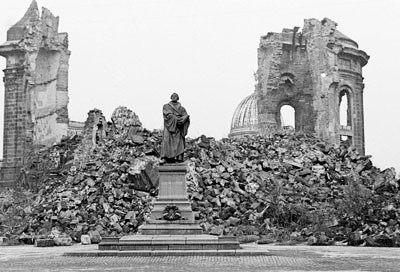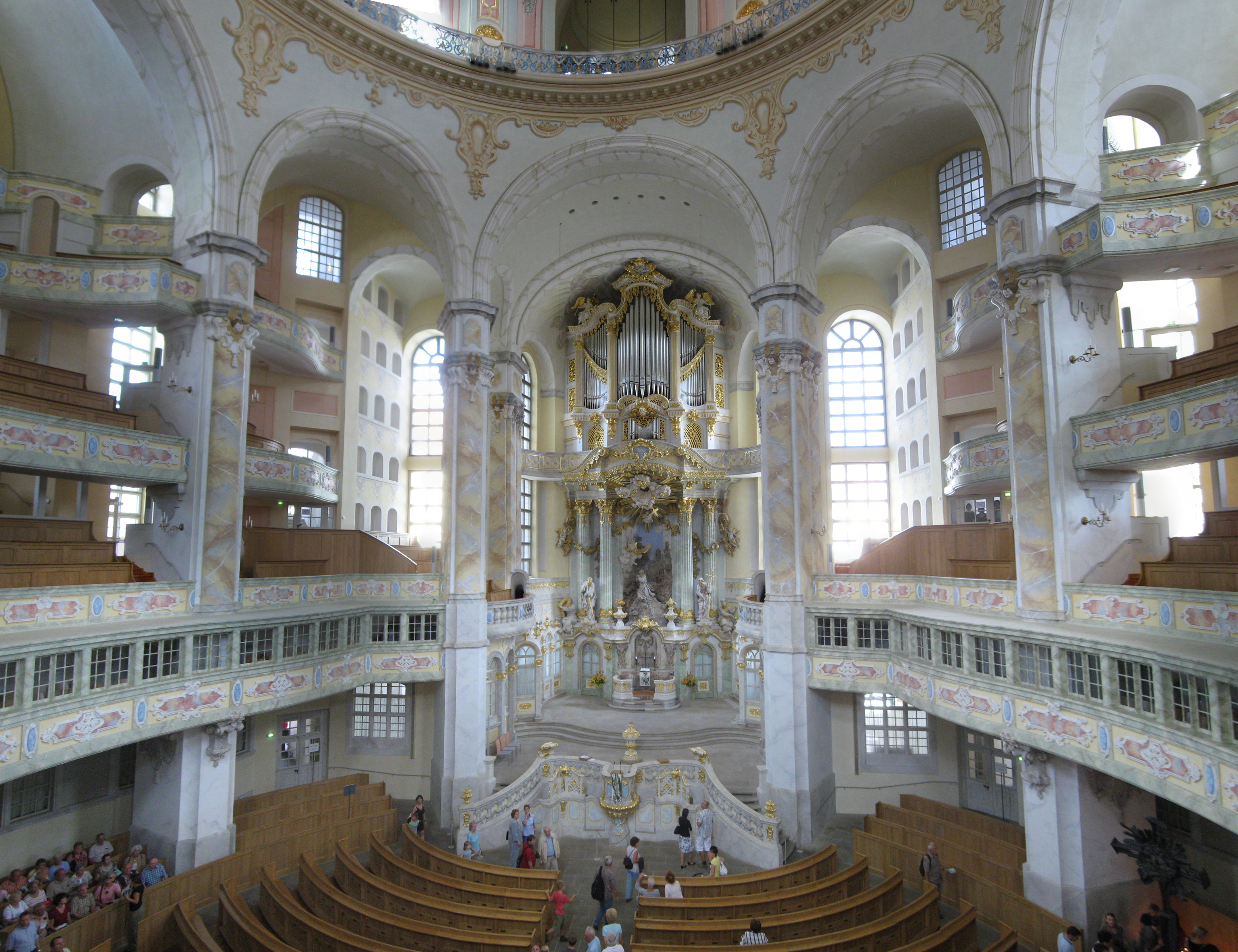Johann Sebastian Bach played the organ at the Lutheran Church of Our Lady in Dresden, which was destroyed in the allied bombing of that city during World War II. Later, the ruins of that building became a center of protest against East German Communism. Now the church has been rebuilt, using the rubble as well as new material. Tomorrow it will be reconsecrated.
The Wall Street Journal has a fascinating story about the church and its reconstruction, including a good “reading” of the current architecture. Excerpts and pictures after the jump.

Source: Wikipedia, Creative Commons
From A New Old Church Both Reverential and Self-Referential – WSJ:
The Baroque, octagonal “Church of Our Lady,” where Johann Sebastian Bach once played the organ, has always been central to the city’s image. Designed by George Bähr and completed in 1743, the Lutheran church retained the name of the Gothic Catholic one it replaced. Its outstanding feature—a soaring, pillared dome nicknamed the “Stone Bell”—dominated the city’s skyline and symbolized its artistic splendor.
On Feb. 13, 1945, Dresden was firebombed by the Allies, and two days later the Frauenkirche collapsed. . . .
For decades, the Frauenkirche, reduced largely to a deteriorating pile of rubble, served as an antiwar memorial. In the 1980s, it became a locus of protest against East German political oppression.
On the 45th anniversary of the bombing, just months after the fall of the Berlin Wall, a cross-section of Dresdeners published an “Appeal From Dresden” calling for an international foundation to rebuild the church as a “House of Peace.” Renouncing the guise of innocence, the appeal stated: “We are painfully aware that Germany started the Second World War.”
Dresdeners, revering tradition, wanted their old church back—but with a transformational twist or two. Using the original plans, surviving remnants and modern engineering, they performed an act of reconstruction that turned out to be precise and reverential, but also self-reflexive.
In its mission and its architecture, the Frauenkirche now manages to look both backward and forward. About 45% of the church is made of historical materials. The façade is the most striking example. The charred sandstone pieces of the ruined building were salvaged, cataloged and, to the extent possible, returned to their original locations. The gaps were filled by newer, lighter stones from the same quarry outside Dresden. The effect is of an abstract stone tapestry, an uneven mottling of dark and light that simultaneously evokes past and present.
The church dominates the cobblestoned Neumarkt, a rebuilt city square where a statue of Martin Luther presides. Walking around the building one encounters a chunk of the old dome, one of several memorial features.
Entering the church precipitates a sudden lift in mood: The Baroque interior is spacious and exuberant, a symphony of unexpected light and color. Windows admit abundant sunlight; galleries ring the gracefully curving wooden pews. The organ and the altar, depicting Jesus in the Garden of Gethsemane, are gilded and intricately carved.
The eye inevitably drifts upward to the bright-hued frescoes on the inner dome. Painted by Christoph Wetzel in replication of Giovanni Battista Grone’s originals, they depict the four Evangelists—Matthew, Mark, Luke and John—and allegories of Faith, Hope, Love and Charity. Climbing the dome for a city view, visitors encounter fragments from the cathedrals of Cologne, Aachen and Strasbourg, also casualties of war.
Meticulous as the reconstruction has been—the altar was almost entirely pieced together from shards of the original—there are deliberate reminders that this is not the prewar church. On the altar is a newly forged Cross of Nails, a link to a similar cross at the rebuilt cathedral in Coventry, England, destroyed by German
bombers in 1940. The pillars alongside the altar, displaying wartime damage, are missing the angel-head carvings visible elsewhere.
The church’s old pinnacle cross, charred and twisted, sits in the south nave, where visitors may light a memorial candle and inscribe their thoughts. The gilded cross—an exact replica—that now crowns the bell tower was a gift from Britain, fashioned by Alan Smith, the son of one of the bombers of Dresden.
Source: Wikipedia, Creative Commons
Source: Wikipedia Creative Commons














